Russian WW1 Armored Cars
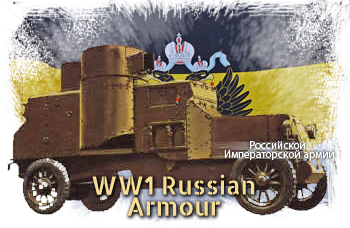
Models
Context before 1905
Important reforms were introduced by Count Dmitry Milyutin during his long career which spanned from 1861 to 1881. He strove to create a modern army out of a system which inherited from the Napoleonic Wars the organisation, tactics and recruitment. The first step was the recruitment, with a levy system and military districts division. He also instituted permanent barracks for the troops, a proper military education and elementary education, for all draftees. The Tsar later approved compulsory military service for all 20 year-old males, for a 6-month long term engagement, which created a large army of experienced reservists in case of war, while retaining a small professional standing army. This was done in 1871 and, by 1877, these reforms were seen in action during the Russo-Turkish war.Later, during the Boxer rebellion, 100,000 Russians attempted to secure Manchuria and several clashes or full scale battles erupted in China itself, when the Russians attempted to secure their possessions. Thus tensions were high with China in 1900, but it was unlikely that it would lead to a war with Japan as well. At the same time the army budget was decreased, to the point that only 18% of the state budget was spent for it, and the lion's share was taken by massive naval rearmament, which left the infantry badly equipped in 1905. At the same time, the Tsar sought to acquire, for the first time, modern equipment for the army and purchased French Charron armored cars, the first Russian armored vehicles in service.
Consequences of the Russo-Japanese war
The crushing defeats of Tsushima, the battle of Mukden and the siege of Port Arthur, combined with poor living conditions for the troops -both infantry and navy- culminated with a full scale mutiny within the navy (onboard the Potemkin), and around 400 mutinies from the infantry. Morale was constantly lowered by requests for maintaining order. Over 1500 civilian protests were crushed by the cavalry and infantry in a short period of time. These events shook the army to the core and revolutionary ideas began to percolate with more efficiency than ever. However, by sheer brutal discipline, aristocratic officers generally succeeded to maintain order until 1914, when the war broke out with Germany.A lack of automotive industry
By the time armored vehicles were necessary, local conditions were lacking for such an endeavor. There were local automotive workshops performing assemblies of foreign components for a few wealthy aristocrats, but no real industry before the appearance of the Russo-Balt wagon Factory (RBVZ) in Riga, Latvia. The latter was able, in 1908, to manufactures lorries and trucks in numbers. Until 1915 and its evacuation, 450 vehicles had been delivered so far. Engineer Dvinistkiy proposed a project of a steam-powered armored car, soon judged impractical. The first concrete attempt came during the Russo-Japanese war from a Cossack officer of the Manchurian Army, M. Nakashidze.He began work on a turreted vehicle, but the War Ministry, although impressed, doubted the capacity of building such vehicles locally from scratch and turned to French manufacturer Charron, Girardot & Voigt to deliver a prototype. It was later adopted after successful trials to the Izhorskiy factory at Kolpino, near St Petersburg. However, ten more Charrons were ordered and only eight were received, two being stolen by the Germans in the meantime.
The war of 1914
At that time the Tsar had send requests to foreign industrial companies to send armored cars projects or to make offers for already existing models, and many were bought at the same time. Also, in 1914 the first Russian tank was devised (Vezdekhod or "Go Anywhere"), a snail-like small tank, with a single central track and steering wheels, but also a fully rotating turret. Despite being ahead of its time, the project was rejected by the Stavka (the general headquarters) since they estimated the army had no need for these machines. They were badly criticized afterwards when in 1916, the British and, soon after, the French unleashed hundreds of tanks on the battlefield. Tank development was launched again, with the full support from the head of staff; but it was already too late.Most Russian armored cars were based on foreign models, modified or entirely produced locally. The most used was the famous Austin-Putilov, based on local built Austin trucks, armored and equipped by the Putilov Arsenal and Imperial Works. Other providers were FIAT, Armstrong-Withworth, Isotta-Fraschini, Sheffield Simplex, Austin (UK), Jeffery, Lanchester, Renault, White, Peerless and perhaps Ford. Generally, these were small series of 3 to 15 machines acquired early in the war. These armored cars were of all sizes, generally with one or multiple turrets.
A talented French engineer, Adolphe Kégresse, devised a new kind of flexible tracks. This led to a small series of all-terrain vehicles and conversions for the Tsar and general staff starting in 1906, and later gave birth to the world's first armored half-track car, the Austin-Kégresse. It was well suited for the Asiatic front and Russian roads and climate in general. They were popularly called "tanks" by the army, despite their mixed nature. Around 60 would be delivered until the fall of 1917. Another model, the Putilov-Bullock, was also built in limited numbers.
Gradually, locally produced components were preferred to predominantly British models. There was a "pool" of small manufacturers in the vicinity St Petersburg, namely Obukhov Works, Izhorsky Factory and Putilov Works, the most famous. Izhorksy built nearly 120 vehicles based on foreign chassis (FIAT, Pierce-Arrow & Peerless), including their own half-track models based on the Palmers & Lombard agricultural tractor. Putilov was more prolific, turning 250 vehicles based on Austin and Packard chassis. But despite the optimistic prospects of the war ministry, which hoped to accept in service 200 armored cars and 50 half-tracks each year, at the end of the war there were a total of 300 armored vehicles split into 52 units.
The Russian armored cars in action
Tactical organization of these vehicles called for small platoons of two broneavtomobil (cars with machine-guns) and a single pusheshniy broneavtomobil (gun car) to deal with heavier targets. Each detachment was composed of 100 men, had 21 lorries and support vehicles and formed companies of 12 light and three heavy armored cars. They were attached to rifle divisions and called to perform many tasks, from traditional scout and reconnaissance patrols to close fire support.Armored cars were used in numbers, with over 30 different types in use and many more tested, sometimes operationally, but usually in limited numbers. This cruel lack of standardization provoked a shortage of spare parts and an ordnance nightmare to deliver the right ammunition. Plus, having by design a high ground pressure, these vehicles were limited in range and speed by the poor quality of the roads encountered in Western Russia, Belarus and Ukraine, doomed by the snow in winter and thick mud in autumn and spring. Only by the fall of 1916 the general staff decided to adopt "true" western-style tanks and at the same time gave a new dynamic to various local tank projects. The unusual Vezdekhod was funded, but so were more disturbing projects like the gigantic, even grotesque tricycle called "Tsar Tank".
A project of M. Lebdenko, head of the experimental laboratory of the war ministry, this vehicle was built and tested in the summer 1915, but soon fell under heavy criticism because of its sheer size, lack of power and protection. Eventually orders were made at the beginning of 1917 for the French Renault FT, British Mark V and Whippet. There were also projects to build some under license, but none had been delivered when the regime collapsed.
Revolution and Civil War
The war ended with the revolution in October 1917, Kerensky taking power through a provisional government and asking for an armistice. But the "peace" quickly gave way to a brutal struggle between the RKKA (The Workers' and Peasants' Red Army) and a coalition of western troops already stationed on the Eastern front and counter-revolutionary units. This will degenerate into a full scale civil war between the "reds" and the "whites", the last supported by the western powers. If the first were keen to capture and re-use as many disparate and worn-out armored cars as they could, the latter had nothing but a few armored trains, but were later given western tanks of the latest models.In January 1919, the "whites" under General Wrangel launched an assault on Odessa, supported by French FTs. One of these was later captured by the Red Army. It was the basis for future tank development. In April 1919, the "whites" under Wrangel and Deniken were given 57 tanks, mainly Mark Vs with British crews. These were lately captured, notably because of the lack of experience and training of the Russian crews. By 1921 the "Reds" had gradually captured around 80 tanks. A new story could begin, that of Soviet tank development.
Light armored cars
Nakashidze-Charron
A vehicle designed by the Russian officer Nakashidze and built in 1906 on a Charron-Girardot-Voight landaulet. The first vehicle ever to have this standard armored car configuration with a fully revolving turret at the rear and armored windshields.Armstrong-Withworth 1913
Ordered by the Russian army to the British manufacturer AW before the war. Two turrets and different models.Izhorsky FIAT
Designed by officer Izhorsky on the FIAT 12PS 5,3 t 4x2 lorry chassis, 60 hp and 60 kph. 47 built, 2 turrets and armed with 2 x 7.62 mm (0.3 in) machine-guns, protected by 5 to 8 mm (0.2-0.3 in) of amour, crew 4 or 5.Medium armored cars

Captain Vladimir Mgebrov, who had a considerable influence on Russian armored cars design, does deserve a few words. Born in Moscow in 1886, he served during the opening of the war in a training automobile company, soon reformed as the Military driving school, later transferred to the 1st Spare Car Company.
He was a prolific and gifted inventor, leading to the creation of the bulletproof glass and rifle grenade, but also about 20 armored cars, some built in series and some unique, with armor designs meant to improve their all-angle protection. These were no prototypes and served actively not only until 1917, but also during the Civil War. Capt. Mgebrov was also a war hero, posthumously awarded the Order of Saint George, IV Degree (he died on August 21, 1915, while leading a counter-attack with his new rifle grenades). Outside the 11 Mgebrov-Renault, he built 5 more types of armored cars based.
Mgebrov Renault
Built using Renault lorries chassis, apparently in 11 units, with a well-studied sloped armor.Mgebrov White
Same kind of vehicle based on the White chassis, with a less sloped armor, but a 37 mm (1.45 in) naval gun.Mgebrov Benz
Conceived by Officer Mgebrov in 1915. Very similar to the Mgebrov Renault.Mgebrov Isotta-Fraschini
Based on an Isotta-Fraschini chassis.Russo-Balt type C (S)
8 built in 1914. 4 t, 40 hp, 4x2 vehicle, speed 20 km/h (12 mph), 5 crew, 3-5 mm (0.2-0.3 in) protection, armed with 3 x 7.62 mm (0.3 in) machine-guns.Nekrasova armored car
10 built in 1915, armed with a QF 37 mm (1.45 in) gun and 3 x 7.62 mm (0.3 in) machine-guns.Russo-Balt type T
1916, 10 built, 11 tons AA lorries armed with a 76 mm (3 in) flak gun.Austin Putilov
Or "Russian Austin" as designated. 33 built in 1919-1920. Armed with two turrets en échelon.Armstrong-Withworth-FIAT
Based on Fiat 3-1/2 tons trucks.Heavy armored cars
Pierce-Arrow
Similar to the British vehicle, armed with a Vickers QF 2-pdr AA.Putilov-Garford
Based on the US Garford 5-ton lorry, modified and equipped at Putilov works with a 75 mm (2.95 in) field gun in the rear turret and two machine guns in forward sponsons. Around 12 produced in 1914.Half-tracks armored cars
Austin-Kégresse
12 were built from in 1919-1920.Putilov-Bullock
About 10 built.Tanks
Vezdhekod Tank
Single track configuration. Just 1 prototype built and tested in March-December 1915. Cancelled, then reopened in October 1916. No production known nor operational service.Links about WWI Russian AFVs
Some figures about Russian WWI armored cars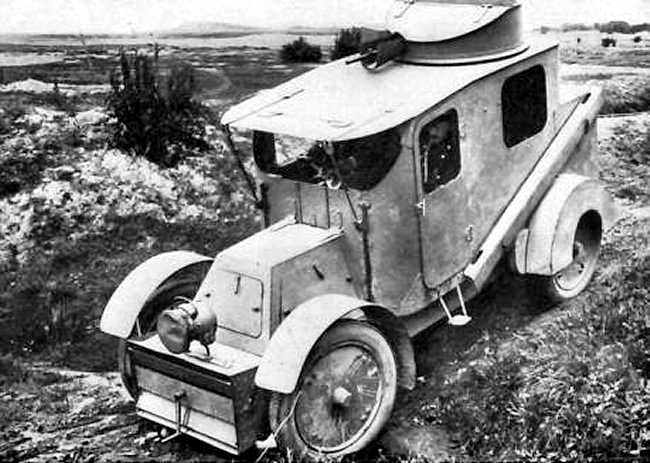
The Nakashidze-Charron M1906, the very first serie of Russian armored cars.

Armstrong-Withworth 1913, here a Russian copy built in 1915 on a FIAT chassis. Captured in Vladivostock in 1919 by the Japanese.
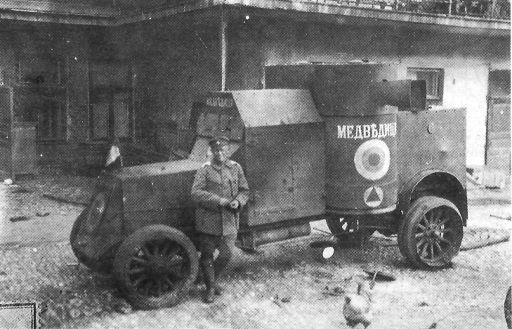
The Putilov Austin, a highly successful and prolific model.
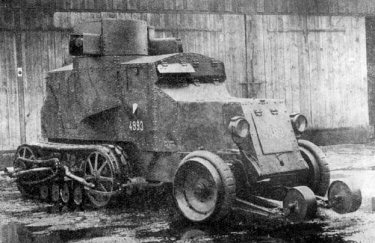
The Austin Kégresse, world's first armored half-track.
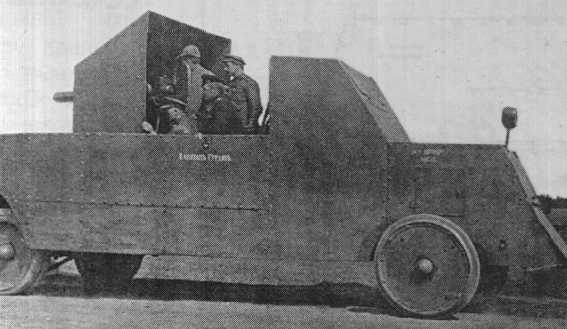
The heavy Packard-Izorsk on duty, sporting a 37 mm gun, for infantry support and AA defense alike.
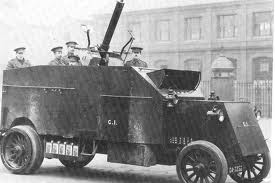
An Izhorsky-Peerless truck with a 40 mm (1.57 in) gun mounted on it, mostly used during the Russian Civil War (1919-1921) against air targets.
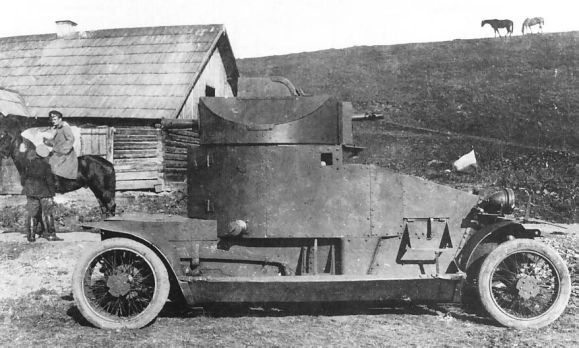
A Lanchester in Russian service. Many others served with the RNAS in Russia, manned by British crews. The Russian version had a 37 mm (1.46 in) quick firing naval gun.
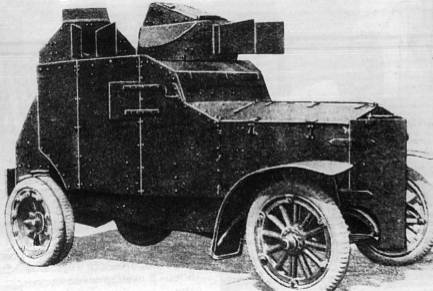
The twin turret Armstrong-Withworth FIAT, partly built locally.
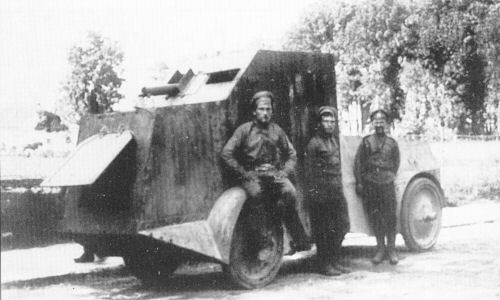
The Poplavko-Jeffrey armored truck, heavily protected for its time with up to 16 mm (0.63 in) of armor.
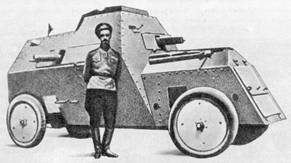
The Russo-Balt M armored car. Around 15 were built.

The Putilov-Garford armored truck.

The Izhorsky-FIAT.
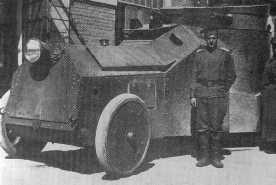
The Mgebrov-Isotta-Fraschini, more conventional than the Renault, and more powerful.
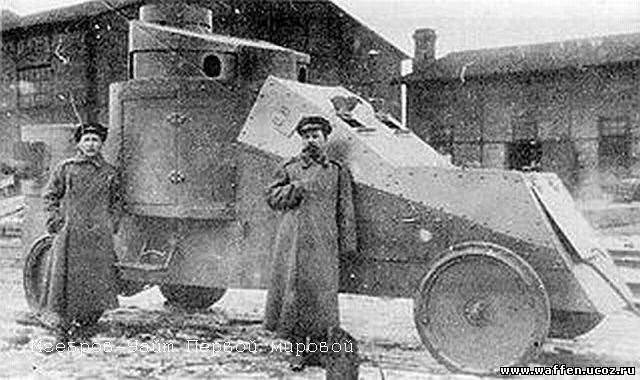
The Mgebrov-White armored car
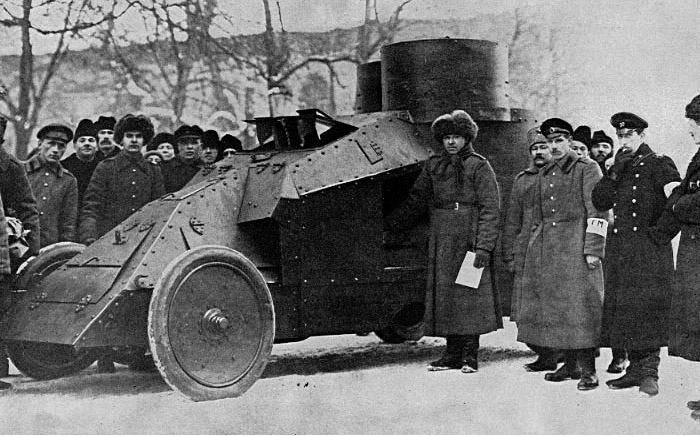
The distinctive, wedge-shaped Mgebrov Renault armored car.
Centennial WW1 POSTER

Illustrations
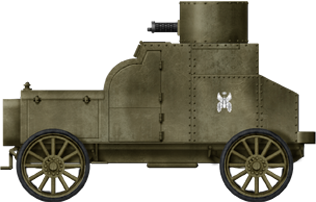
First model, Armstrong-Withworth 1913 with a single turret. Some sources state that a twin machine-gun version was also part of the deliveries, with both machine-guns in sponsons. But since little photographic evidence exists, it could have also been a 1915 or 1919 copy.
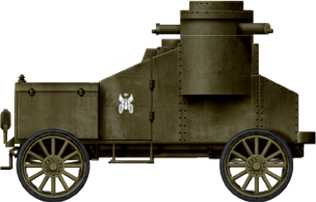
This vehicle was not part of the original batch, but one of three Russian copies built in 1915, probably at Dalzavod works in Vladivostock, on a FIAT chassis.
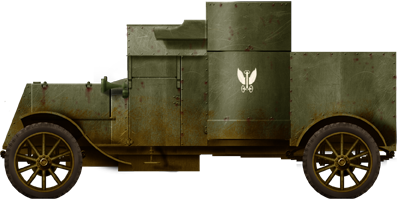
Austin Armoured Car Series I in Russian service.
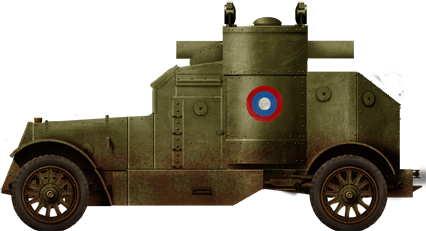
Austin Armoured Car Series II in Russian service.
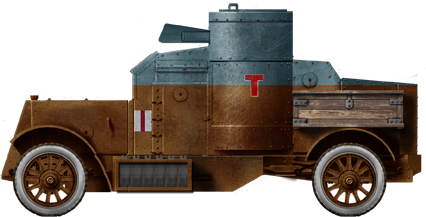
Austin Armoured Car Series III in the famous 1916 bi-tone livery, Russia.
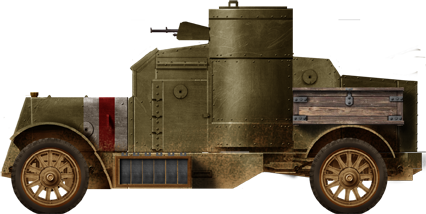
Austin Armoured Car Series III in British service, 1916.
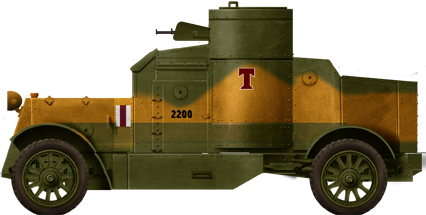
Austin Armoured Car 1918 Pattern in British service, RIC Barracks at Ennis, Country Clare, Ireland, November 1919.
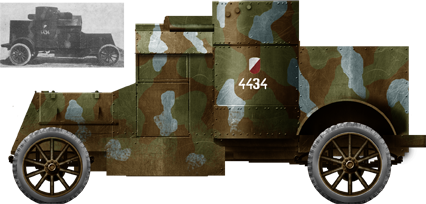
Polish White-Austin armored car "Mars", 1920.
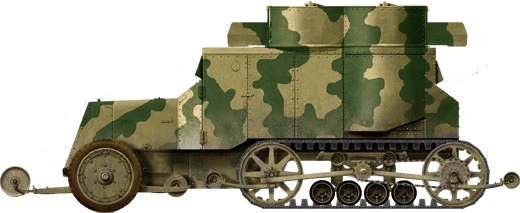
Camouflaged Austin-Kegresse with the trench-crossing extension rollers, 1922
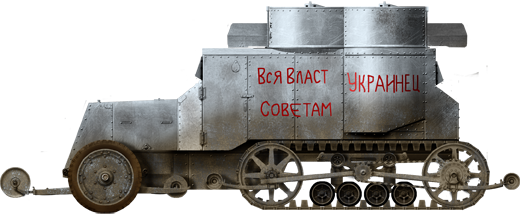
Austin-Kegresse «Ukrainets» in Zhytomyr, 1920, Polish-Russian war
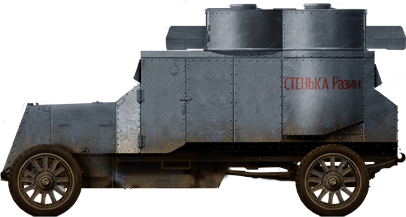
"Styenka Razin", 1920. It was captured by the 55th Infantry Regiment of the 14th Wielkopolska Infantry Division during the Soviet-Polish war and renamed "Poznańczyk". It was reused in the Wielkopolski Armored Car Platoon.
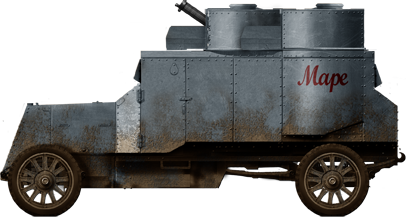
Another Austin-Putilov, in 1920, during the Polish-Soviet war. As customary, these vehicles were individually named by their crews. It seems nearly all have been delivered with a neutral grey paint, or possibly pale olive, photos can\'t really tell, but it's unlikely as the paint would have been available from the Naval stocks.
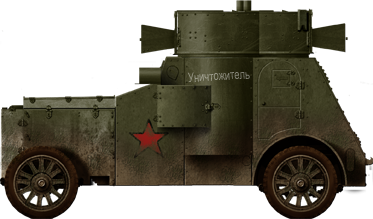
In Bolshevik service, 1918. The vehicle is often confounded with the Armstrong-Withworth-FIAT armored cars built in the UK, also based on the same US-built FIAT chassis, but delivered earlier.

Mgebrov-White in Russian service, 1915.

The sole Mgebrov-Isotta-Fraschini in Russian service, 1915

Mgebrov-Renault in Russian service, 1915. The first model had two machine-guns in a large, bulky rotating superstructure instead of a turret.

"Paris Commune" operated by a Soviet independent unit, winter 1917. This early illustration is innacurate and will be redone.

Poplavko-Jeffery in Russian service, in the "special purpose division", December 1917, equipped with its wire-cutter skid. The superstructure could hold up to four machine-guns, but usually only one or two ports were used at a time.

"Janicek", briefly operated by Czech troops, allied to the White Russians, under the command of General Janin during the Russian Civil War. This vehicle was recaptured by the Red Army.

Imperial Russian "Sokol II" in 1915.

Latvian "Kurzemiesk" with a three-tone camouflage, circa 1920.

German Freikorps's Garford-Putilov, with the distinctive skull and crossbones.
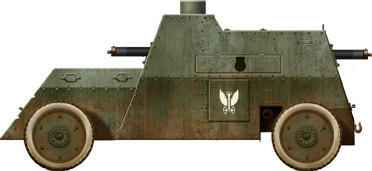
Russo Balt C in Russian service, 1915.
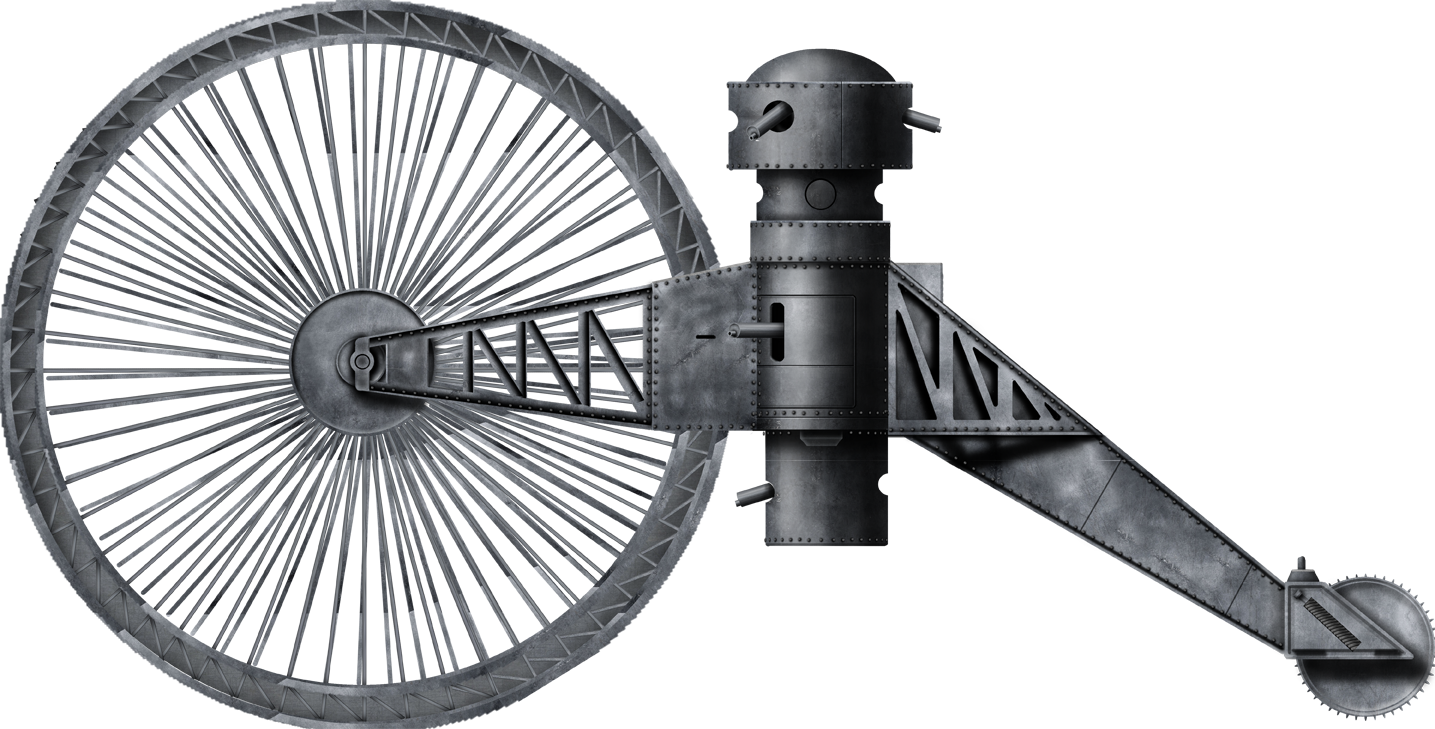
tsar tank

The Great War
 Austria-Hungary
Austria-Hungary Belgium
Belgium British Empire
British Empire France
France German Empire
German Empire Italy
Italy Russia
Russia USA
USAWW1 tanks posters
